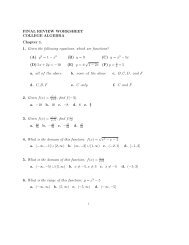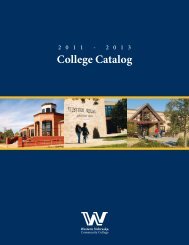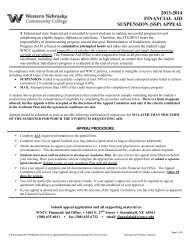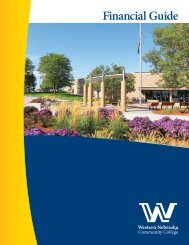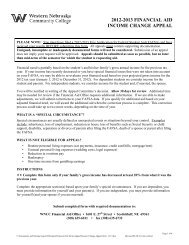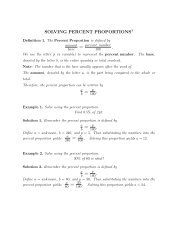WNCC 2010 Self-Study Report - Western Nebraska Community ...
WNCC 2010 Self-Study Report - Western Nebraska Community ...
WNCC 2010 Self-Study Report - Western Nebraska Community ...
You also want an ePaper? Increase the reach of your titles
YUMPU automatically turns print PDFs into web optimized ePapers that Google loves.
Criterion 5: Engagement and Service<br />
As called for by its mission, the organization identifies its constituencies<br />
and serves them in ways both value.<br />
Criterion 5a: <strong>WNCC</strong> learns from the constituencies it serves and analyzes its<br />
capacity to serve their needs and expectations.<br />
<strong>Western</strong> <strong>Nebraska</strong> <strong>Community</strong> College clearly identifies its constituents and listens to them to<br />
discern their needs by convening Program Advisory committees, by building regional<br />
collaborations, and by organizing and producing campus and community events.<br />
Program Advisory Committees<br />
<strong>WNCC</strong> has a number of Advisory Committees in place to guide the direction of various programs<br />
within the College. Vocational and grant programs within the College annually use advisory<br />
committees to provide feedback and recommendations regarding training and equipment to help<br />
the College’s programs stay current with the demands of the workplace. College Advisory<br />
Committees are valuable primarily because they are relevant to student and area needs. For<br />
example, Advisory Committees are used in the following areas:<br />
Table 9-49 Advisory Committees<br />
Emergency Medical Tech<br />
Auto Body Technology<br />
Welding Technology<br />
Adult Education<br />
Perkins Consortium Grant<br />
Nursing<br />
Powerline Technology<br />
Auto Technology<br />
Entrepreneurship<br />
Health Academy<br />
Business<br />
Health Information Technology<br />
Regional Collaborations<br />
The College offers secondary education institutions, health facilities, corporations, non-profit<br />
organizations, and public entities a combination of traditional educational offerings and customized<br />
courses. Once underway, activities are analyzed to determine the scope and quality of service, as<br />
well as whether student needs are being met, the monitoring done to help determine future needs<br />
or areas for expansion of services. The number of students served through these partnerships can<br />
be found in the discussion under Core Component 5c, page 168. A sampling of regional<br />
partnerships includes the following collaborative ventures.<br />
1. In collaboration with regional high schools, dual-credit instruction has been offered by the<br />
College for over 25 years, at <strong>WNCC</strong> campuses, on-site at high schools by certified<br />
adjuncts, and via the ITV system. In 2007, for instance, dual-credit instruction accounted<br />
for 68 courses, just over 6% of total courses and 308 students (see chart page 163).<br />
<strong>Western</strong> <strong>Nebraska</strong> <strong>Community</strong> College Page 157



